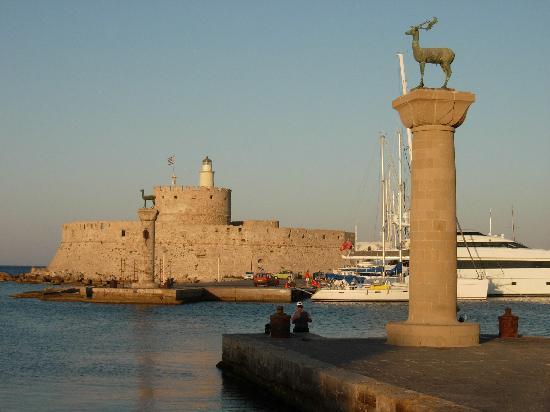The classical Greek lyric poet Pindar sang of the birth of Rhodes, the daughter of Helios the sun god and the nymph Rhoda. This sun-drenched and naturally bounteous island in the southeastern corner of Greece’s archipelago today has been dubbed the “island of roses,” living up to the romantic myth. In Greece’s post-1960 tourism boom, it grew into one of the main poles of attraction in the eastern Mediterranean, boasting diverse natural beauty, some of the country’s finest hotels, impressive monuments and a vibrant nightlife.
Much later, the crusading Knights of St John decided to settle here in 1309 and stayed until 1522, when they were ousted by the Ottomans. One of their legacies is the beautiful and remarkably well-preserved Gothic-style medieval walled city they built (a UNESCO World Heritage monument) in the island’s capital (pop. 45,000). The Italians, who succeeded the Ottomans in 1912, tried hard to make the island a showcase of their colonial achievements and added to the city’s impressive architectural diversity a number of rather imposing, fascist-style buildings near Mandraki, where the heart of Rhodes now beats.
On the eastern side, Koskinou (10 km from town) has excellent examples of traditional architecture and a related museum; Faliraki, 5 km further south, is one of the island’s biggest resorts, with huge hotel complexes along an endless beach with crystal-clear waters. Three kilometers on along the same road is Anthony Quinn Beach, named after the Mexican-American actor who played a leading role in the 1961 production ‘The Guns of Navarone,” which was filmed there.
Afantou (20 km) is one of Rhodes’s oldest villages, well known for its oranges and olive oil, the huge, superb beach and the cultural events of both its Carnival season and August 15 holiday. It is also home to one of Greece’s most prominent 18-hole golf courses, open throughout the year.
In Archangelos (30 km), you will see elderly inhabitants (mainly women) dressed in traditional costumes and can admire the rich and colorful decor and layout of houses. It is well known for its traditional crafts and excellent cuisine. You can also see the Church of the Archangel Michael and its 600-year-old bell tower, and taste excellent bread from wood-burning ovens.
On the western side of the island lies Ialysos (or Trianta, 8 km) -- one of ancient Rhodes’s three city states, along with Lindos and Kameiros. More than half of the island’s hotels are located along its lengthy beach.
A winding road takes you to the top of Mt Filerimos (about 5 km), with a host of antiquities and superb panoramic views.
Twenty kilometers out of town is the renowned and unique Butterfly Valley (“Petaloudes”), a narrow lush valley where thousands of a particular species of the Jersey tiger moth (Panaxia quadripunctaria) come to breed from June to September. Finally, Kameiros (37 km) on the northwestern coast, is the other major archaeological site on the island, where the ancient city has been excavated and preserved in very good condition.
Author: Haris Argyropoulos | Source: ekathimerini [July 15, 2011]
The Best Guide
Sunday, July 17, 2016